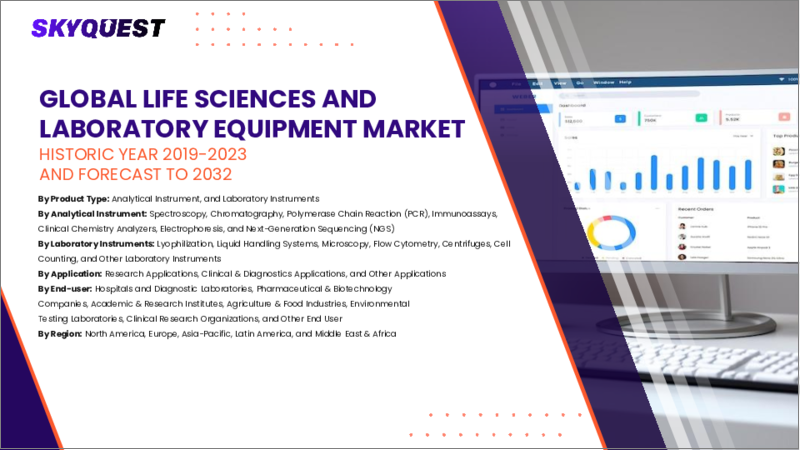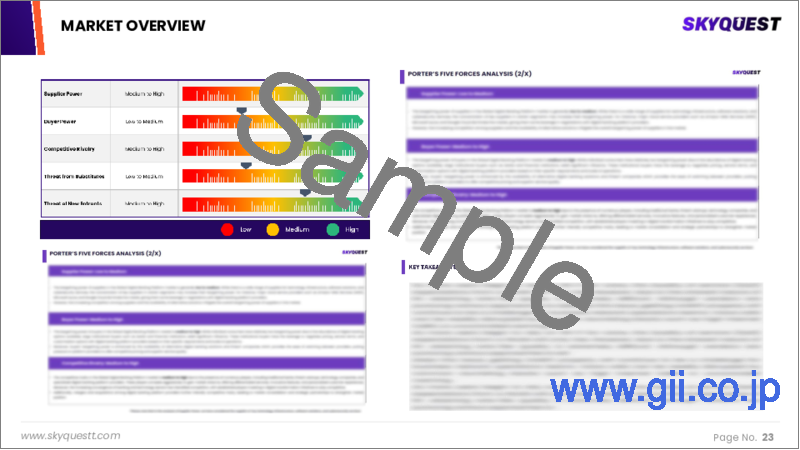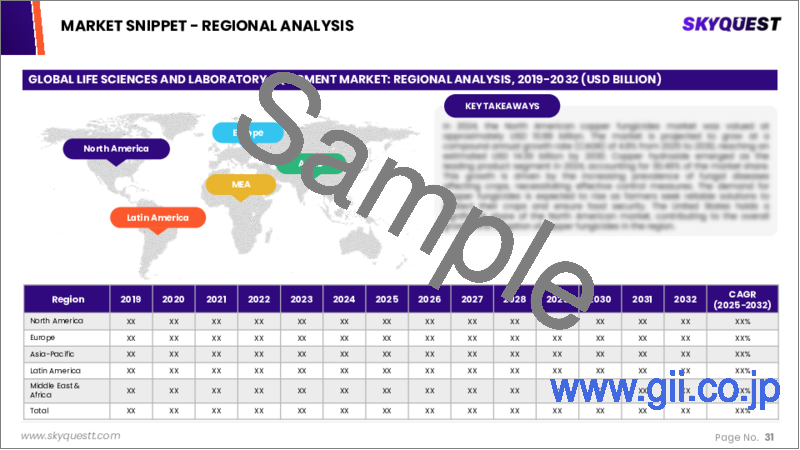|
|
市場調査レポート
商品コード
1623697
ライフサイエンスとラボ用機器の市場規模、シェア、成長分析、機器タイプ別、技術タイプ別、用途別、エンドユーザー別、地域別 - 産業予測、2025~2032年Life Sciences and Laboratory Equipment Market Size, Share, Growth Analysis, By Equipment Type (Cold Storage, Lab Ovens & Furnaces), By Technology Type (Spectroscopy, Chromatography), By Application, By End User, By Region - Industry Forecast 2025-2032 |
||||||
|
|||||||
| ライフサイエンスとラボ用機器の市場規模、シェア、成長分析、機器タイプ別、技術タイプ別、用途別、エンドユーザー別、地域別 - 産業予測、2025~2032年 |
|
出版日: 2024年12月26日
発行: SkyQuest
ページ情報: 英文 157 Pages
納期: 3~5営業日
|
全表示
- 概要
- 目次
ライフサイエンスとラボ用機器の世界市場規模は2023年に544億8,000万米ドルとなり、予測期間(2025-2032年)のCAGRは5.8%で、2024年の576億4,000万米ドルから2032年には904億9,000万米ドルに成長する見通しです。
世界のライフサイエンスとラボ用機器市場は、ライフサイエンス分野への投資の高まり、臨床能力の進歩、産学連携の増加などを背景に力強い成長を遂げています。製薬、バイオテクノロジー、ヘルスケアなどの主要セクターは、戦略的提携、技術の進歩、必須ツールへのアクセス向上などの恩恵を受けています。創薬プロセスでは、高度な技術と自動化システムへの依存度が高まっており、最先端の実験機器への需要がさらに高まっています。さらに、個別化医療が重視されるようになり、効果的なデータ分析と管理システムの必要性が高まっていることも、市場拡大に大きく寄与しています。しかし、先端機器に関連する高コストが課題となり、今後数年間の市場全体の成長に影響を与える可能性があります。
目次
イントロダクション
- 調査の目的
- 調査範囲
- 定義
調査手法
- 情報調達
- 二次データと一次データの方法
- 市場規模予測
- 市場の前提条件と制限
エグゼクティブサマリー
- 世界市場の見通し
- 供給と需要の動向分析
- セグメント別機会分析
市場力学と見通し
- 市場概要
- 市場規模
- 市場力学
- 促進要因と機会
- 抑制要因と課題
- ポーターの分析
主な市場の考察
- 重要成功要因
- 競合の程度
- 主な投資機会
- 市場エコシステム
- 市場の魅力指数(2024年)
- PESTEL分析
- マクロ経済指標
- バリューチェーン分析
- 価格分析
- 技術分析
- 特許分析
- ケーススタディ分析
- 規制分析
ライフサイエンスとラボ用機器市場規模:機器タイプ別
- 市場概要
- 冷蔵
- 実験室用オーブンと炉
- 液体ハンドリング
- 研究室用遠心分離機とシェーカー
- 微生物インキュベーターと環境チャンバー
- ウォーターバス
- サーキュレーターとチラー
- 分析・計測機器
ライフサイエンスとラボ用機器市場規模:技術タイプ別
- 市場概要
- 分光法
- クロマトグラフィー
- PCR
- 免疫測定
- 凍結乾燥
- 臨床化学分析装置
- 顕微鏡検査
- フローサイトメトリー
- 遠心分離機
- 電気泳動
ライフサイエンスとラボ用機器市場規模:用途別
- 市場概要
- 細胞培養と細胞治療
- がん調査
- 創薬
- ゲノミクス
- 体外受精
- バイオプロセス
- メタボロミクス
- プロテオミクス
ライフサイエンスとラボ用機器市場規模:エンドユーザー別
- 市場概要
- 臨床および診断
- 調査学術政府機関
- 医薬品・バイオテクノロジー
- 血液銀行
ライフサイエンスとラボ用機器市場規模
- 北米
- 米国
- カナダ
- 欧州
- ドイツ
- スペイン
- フランス
- 英国
- イタリア
- その他欧州地域
- アジア太平洋地域
- 中国
- インド
- 日本
- 韓国
- その他アジア太平洋地域
- ラテンアメリカ
- ブラジル
- その他ラテンアメリカ地域
- 中東・アフリカ
- GCC諸国
- 南アフリカ
- その他中東・アフリカ
競合情報
- 上位5社の比較
- 主要企業の市場ポジショニング(2024年)
- 主な市場企業が採用した戦略
- 市場の最近の動向
- 企業の市場シェア分析(2024年)
- 主要企業の企業プロファイル
- 会社概要
- 製品ポートフォリオ分析
- セグメント別シェア分析
- 収益の前年比比較(2022-2024)
主要企業プロファイル
- Thermo Fisher Scientific Inc.(US)
- Danaher Corporation(US)
- Agilent Technologies, Inc.(US)
- Illumina, Inc.(US)
- Waters Corporation(US)
- Bio-Rad Laboratories, Inc.(US)
- PerkinElmer, Inc.(US)
- Bruker Corporation(US)
- Qiagen N.V.(Germany)
- GE Healthcare Life Sciences(US)
- Becton, Dickinson and Company(US)
- Merck KGaA(Germany)
- Shimadzu Corporation(Japan)
- Sartorius AG(Germany)
- Charles River Laboratories International, Inc.(US)
- Lonza Group AG(Switzerland)
- Eppendorf AG(Germany)
- Olympus Corporation(Japan)
- Bio-Techne Corporation(US)
- F. Hoffmann-La Roche AG(Switzerland)
結論と推奨事項
Global Life Sciences and Laboratory Equipment Market size was valued at USD 54.48 billion in 2023 and is poised to grow from USD 57.64 billion in 2024 to USD 90.49 billion by 2032, growing at a CAGR of 5.8% during the forecast period (2025-2032).
The global life sciences and laboratory equipment market is experiencing robust growth driven by heightened investments in life sciences, advancements in clinical capabilities, and increased academic-industry partnerships. Key sectors including pharmaceuticals, biotechnology, and healthcare are benefitting from strategic collaborations, technological advancements, and improved access to essential tools. The drug discovery process is increasingly reliant on sophisticated technologies and automation systems, further fueling demand for cutting-edge laboratory equipment. Additionally, the growing emphasis on personalized medicine and the need for effective data analysis and management systems contribute significantly to market expansion. However, the high costs associated with advanced instruments may pose challenges, potentially impacting overall market growth in the coming years.
Top-down and bottom-up approaches were used to estimate and validate the size of the Global Life Sciences And Laboratory Equipment market and to estimate the size of various other dependent submarkets. The research methodology used to estimate the market size includes the following details: The key players in the market were identified through secondary research, and their market shares in the respective regions were determined through primary and secondary research. This entire procedure includes the study of the annual and financial reports of the top market players and extensive interviews for key insights from industry leaders such as CEOs, VPs, directors, and marketing executives. All percentage shares split, and breakdowns were determined using secondary sources and verified through Primary sources. All possible parameters that affect the markets covered in this research study have been accounted for, viewed in extensive detail, verified through primary research, and analyzed to get the final quantitative and qualitative data.
Global Life Sciences And Laboratory Equipment Market Segmental Analysis
Global Life Sciences and Laboratory Equipment Market is segmented by equipment type, technology type, application, end user and region. Based on equipment type, the market is segmented into cold storage, lab ovens & furnaces, liquid handling, lab centrifuges & shakers, microbiological incubators & environmental chambers, water baths, circulators & chillers and analytical & measuring instruments. Based on technology type, the market is segmented into spectroscopy, chromatography, PCR, immunoassays, lyophilization, clinical chemistry analyzers, microscopy, flow cytometry, centrifuges and electrophoresis. Based on application, the market is segmented into cell culture & cell therapy, cancer research, drug discovery, genomics, in vitro fertilization, bioprocess, metabolomics and proteomics. Based on end user, the market is segmented into clinical & diagnostics, research, academic & government institutions, pharmaceuticals & biotechnology and blood banks. Based on region, the market is segmented into North America, Europe, Asia Pacific, Latin America and Middle East & Africa.
Driver of the Global Life Sciences And Laboratory Equipment Market
The Global Life Sciences and Laboratory Equipment market is significantly influenced by the rising prevalence of infectious diseases, including HIV, Ebola, and tuberculosis. This surge in infectious diseases is contributing to the market's expansion, as highlighted by the World Health Organization's report indicating that approximately 1.4 million individuals are currently affected by tuberculosis. Consequently, the demand for various laboratory equipment, such as homogenizers and spectrophotometers, is witnessing a notable increase. This heightened demand for advanced laboratory tools is a crucial driver for the growth of the market, as stakeholders seek to enhance diagnostic and research capabilities in response to these health challenges.
Restraints in the Global Life Sciences And Laboratory Equipment Market
Global Life Sciences and Laboratory Equipment must adhere to stringent regulations and standards to ensure product safety, efficacy, and reliability. Companies in this sector are required to maintain rigorous quality control, conduct comprehensive testing, and comply with Good Manufacturing Practices (GMP) as mandated by regulatory agencies such as the FDA and EMA. Furthermore, adherence to international standards like ISO and environmental regulations cannot be overlooked. Additionally, ethical considerations, including transparent reporting of clinical trials and respecting patient confidentiality, are critical. Failure to comply with these restrictions may result in severe penalties, including legal action, fines, and damage to reputation.
Market Trends of the Global Life Sciences And Laboratory Equipment Market
The Global Life Sciences and Laboratory Equipment market is witnessing a significant shift towards the adoption of advanced wireless technologies, exemplified by products like the Smart Tracker Bluetooth Temperature Data Logger. This trend underscores the growing demand for smart, mobile-enabled solutions that enhance operational efficiency and data accuracy in temperature-sensitive environments. These wireless devices offer features such as Bluetooth connectivity and real-time monitoring through user-friendly apps, catering to the evolving needs of laboratories and research facilities. As the industry continues to prioritize connectivity, ease of use, and data integrity, such innovations are expected to drive significant growth in the market.
Table of Contents
Introduction
- Objectives of the Study
- Scope of the Report
- Definitions
Research Methodology
- Information Procurement
- Secondary & Primary Data Methods
- Market Size Estimation
- Market Assumptions & Limitations
Executive Summary
- Global Market Outlook
- Supply & Demand Trend Analysis
- Segmental Opportunity Analysis
Market Dynamics & Outlook
- Market Overview
- Market Size
- Market Dynamics
- Drivers & Opportunities
- Restraints & Challenges
- Porters Analysis
- Competitive rivalry
- Threat of substitute
- Bargaining power of buyers
- Threat of new entrants
- Bargaining power of suppliers
Key Market Insights
- Key Success Factors
- Degree of Competition
- Top Investment Pockets
- Market Ecosystem
- Market Attractiveness Index, 2024
- PESTEL Analysis
- Macro-Economic Indicators
- Value Chain Analysis
- Pricing Analysis
- Technology Analysis
- Patent Analysis
- Case Study Analysis
- Regulatory Analysis
Global Life Sciences and Laboratory Equipment Market Size by Equipment Type & CAGR (2025-2032)
- Market Overview
- Cold Storage
- Lab Ovens & Furnaces
- Liquid Handling
- Lab Centrifuges & Shakers
- Microbiological Incubators & Environmental Chambers
- Water Baths
- Circulators & Chillers
- Analytical & Measuring Instruments
Global Life Sciences and Laboratory Equipment Market Size by Technology Type & CAGR (2025-2032)
- Market Overview
- Spectroscopy
- Chromatography
- PCR
- Immunoassays
- Lyophilization
- Clinical Chemistry Analyzers
- Microscopy
- Flow Cytometry
- Centrifuges
- Electrophoresis
Global Life Sciences and Laboratory Equipment Market Size by Application & CAGR (2025-2032)
- Market Overview
- Cell Culture & Cell Therapy
- Cancer Research
- Drug Discovery
- Genomics
- In Vitro Fertilization
- Bioprocess
- Metabolomics
- Proteomics
Global Life Sciences and Laboratory Equipment Market Size by End User & CAGR (2025-2032)
- Market Overview
- Clinical & Diagnostics
- Research, Academic & Government Institutions
- Pharmaceuticals & Biotechnology
- Blood Banks
Global Life Sciences and Laboratory Equipment Market Size & CAGR (2025-2032)
- North America (Equipment Type, Technology Type, Application, End User)
- US
- Canada
- Europe (Equipment Type, Technology Type, Application, End User)
- Germany
- Spain
- France
- UK
- Italy
- Rest of Europe
- Asia Pacific (Equipment Type, Technology Type, Application, End User)
- China
- India
- Japan
- South Korea
- Rest of Asia-Pacific
- Latin America (Equipment Type, Technology Type, Application, End User)
- Brazil
- Rest of Latin America
- Middle East & Africa (Equipment Type, Technology Type, Application, End User)
- GCC Countries
- South Africa
- Rest of Middle East & Africa
Competitive Intelligence
- Top 5 Player Comparison
- Market Positioning of Key Players, 2024
- Strategies Adopted by Key Market Players
- Recent Developments in the Market
- Company Market Share Analysis, 2024
- Company Profiles of All Key Players
- Company Details
- Product Portfolio Analysis
- Company's Segmental Share Analysis
- Revenue Y-O-Y Comparison (2022-2024)
Key Company Profiles
- Thermo Fisher Scientific Inc. (US)
- Company Overview
- Business Segment Overview
- Financial Updates
- Key Developments
- Danaher Corporation (US)
- Company Overview
- Business Segment Overview
- Financial Updates
- Key Developments
- Agilent Technologies, Inc. (US)
- Company Overview
- Business Segment Overview
- Financial Updates
- Key Developments
- Illumina, Inc. (US)
- Company Overview
- Business Segment Overview
- Financial Updates
- Key Developments
- Waters Corporation (US)
- Company Overview
- Business Segment Overview
- Financial Updates
- Key Developments
- Bio-Rad Laboratories, Inc. (US)
- Company Overview
- Business Segment Overview
- Financial Updates
- Key Developments
- PerkinElmer, Inc. (US)
- Company Overview
- Business Segment Overview
- Financial Updates
- Key Developments
- Bruker Corporation (US)
- Company Overview
- Business Segment Overview
- Financial Updates
- Key Developments
- Qiagen N.V. (Germany)
- Company Overview
- Business Segment Overview
- Financial Updates
- Key Developments
- GE Healthcare Life Sciences (US)
- Company Overview
- Business Segment Overview
- Financial Updates
- Key Developments
- Becton, Dickinson and Company (US)
- Company Overview
- Business Segment Overview
- Financial Updates
- Key Developments
- Merck KGaA (Germany)
- Company Overview
- Business Segment Overview
- Financial Updates
- Key Developments
- Shimadzu Corporation (Japan)
- Company Overview
- Business Segment Overview
- Financial Updates
- Key Developments
- Sartorius AG (Germany)
- Company Overview
- Business Segment Overview
- Financial Updates
- Key Developments
- Charles River Laboratories International, Inc. (US)
- Company Overview
- Business Segment Overview
- Financial Updates
- Key Developments
- Lonza Group AG (Switzerland)
- Company Overview
- Business Segment Overview
- Financial Updates
- Key Developments
- Eppendorf AG (Germany)
- Company Overview
- Business Segment Overview
- Financial Updates
- Key Developments
- Olympus Corporation (Japan)
- Company Overview
- Business Segment Overview
- Financial Updates
- Key Developments
- Bio-Techne Corporation (US)
- Company Overview
- Business Segment Overview
- Financial Updates
- Key Developments
- F. Hoffmann-La Roche AG (Switzerland)
- Company Overview
- Business Segment Overview
- Financial Updates
- Key Developments






